
by Chris Roliardi
We awoke once again to a traditional Irish breakfast, and then we were off toward the southwest of Ireland. Our first stop of the day was St. Patrick's Well, a several-acre pond of rapidly flowing underground springs close to Clonmel. Thought to have been a holy site since pagan times, it is said that St. Patrick visited the site and that the natural spring water had the power to cure such maladies as sore lips and eyes, as well as several chronic diseases.
Clonmel to Union Hall
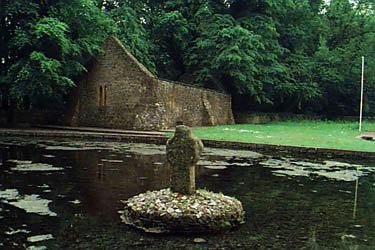
|
| A place of mystery and powerful natural forces, it is easy to understand how local inhabitants from pagan to Christian could find spiritual power at the site of St. Patrick's Well. |
According to the locals whom we met at the well, it reallly does have curative powers, but only if youšre a "true believer." Alongside the well, there is an early Christian church. During the 17th century, Pope Paul granted a 30 year plenary indulgence to anyone who visited the site on ceretain Holy Days.
After the well, we stopped to explore the Mitchelstown Caves, which are known to contain some of the finest cave formations in the country. After the initial 100š vertical drop, we travelled nearly a quarter of the way into the two-mile cavern which was especially awe-inspiring to me, as Išve never been in a cave system before. Our tour was led by the current-generation owner of this private natural wonder, who provided us with an interesting first-person account of cave ownership.
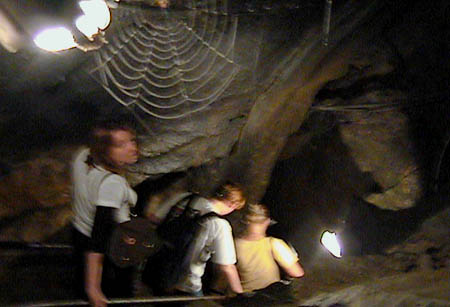
|
| For some of us, the trip into the Mitchelstown Caves was the first cave experience; seeing the wild shapes of slow-forming calcite formations was a real treat. |
Next we went to the Neolithic Drombeg Stone Circle, a ring of stone pillars similar in design to Stonegenge, but of a smaller scale. The monument was constructed between 2,000 and 500 B.C.
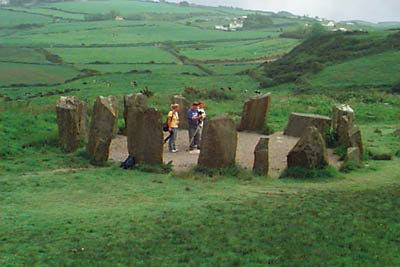
|
| During the 19th century, the cremated remains of a boy were found in the center of the Drombeg Stone Circle. |
Our travels for the day ended, and Phil saw the ocean for the first time, as we entered the small fishing village of Union Hall in Co. Cork. As we walked through this one-street community we began to see into the lives of the local inhabitants.

|
| The bright colors of the houses and pubs were an unexpected treat, as my preconceived notions of a hard-working, no-frills fishing town were in shades of gray. |
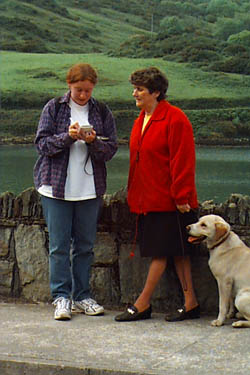
|
| Kellly interviewed a Union Hall woman out walking her dog. |

|
| The closed off "inner harbor" of Union Hall is inhabited by a pair of swans. |
After checking into our B and B right on the waterfront, we walked down to the commercial pier and soon learned that the fisherman we met were some of the friendliest, most personable folks we had yet met on our journey. Kellly and Emily interviewed local fisherman John Cahalane(100 K QT movie) as he mended his nets.
some of the friendliest, most personable folks we had yet met on our journey. They were more than eager to give interviews and pose for portraits with as many of us as necessary. Most impressively, they seemed genuinely interested in how OUR Irish experience was shaping up.
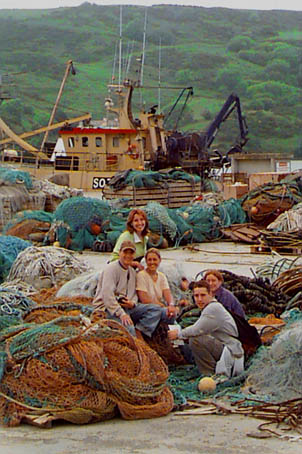
|
| The Bradley group found a number of interesting subjects, and some new friends at the Union Hall fishing boat harbor. |
In the evening after dinner, after writing most of this journal, I found my way into one of the older pubs in town. I ended up having one of the most amazing experiences of my life there when the crowd began singing different Irish folk songs. Most dealt with the various rebellions against the English. But then they began a song about Irish men and woman being forced to leave their homeland to travel to Chicago, escaping the famine of the 1840's. Then I realized that it was my family that they were talking about, as my mother often told me that her family, originally named McCouy, fled Galway in the 1840's for that same reason. While I always knew these stories, I suddenly understood that these stories concerned not only my family but an entire nation of emigrants.
Back